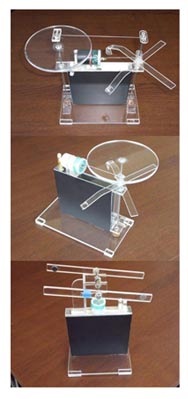 |
|||||||||||||||||||||||||||||
The Stirling Engine for Green Power ProjectsIntroduction:
"A Stirling engine is a heat engine operating by cyclic compression and expansion of air or other gas, the working fluid, at different temperature levels such that there is a net conversion of heat energy to mechanical work. The engine resembles a steam engine in having all heat transfer flowing through the engine wall. This is traditionally designated an external combustion engine in contrast with an internal combustion engine where the heat is put in by combustion of fuel within the body of the working fluid. Unlike the steam engine's usage of water as the working fluid in both its liquid and gaseous phases, the Stirling engine encloses a fixed quantity of permanently gaseous fluid such as air or helium. Typical of heat engines, the general cycle consists of compressing cool gas, heating the gas, expanding the hot gas, and finally cooling the gas before repeating the cycle. Originally conceived in 1816 as an industrial prime mover to rival the steam engine, its practical use was largely confined to low-power domestic applications for over a century.The Stirling engine is noted for its high efficiency (up to 40% in practice), quiet operation, and the ease with which it can use almost any heat source.
This compatibility with alternative and renewable energy sources has become
increasingly significant as the price of conventional fuels rises, and also
in light of concerns such as peak oil and climate change. This engine is
currently exciting interest as the core component of micro combined heat
and power (CHP) units, in which it is more efficient and safer than a comparable
steam engine." -
Intro
from Wikepedia Click for more info.
1000 New Millionaires Every Week? - Take a Look...In my opinion, stirling engines combined with solar power is the future of solar energy. This combination holds the World Record for creating electricity from the sun. Since we already know it's the most effective at turning sunlight to electricity, it comes down to economics and whether this combo can be built as inexpensively as other methods. Be sure to take a look at these two videos:
Engineering a Sterling Engine
Simple, Homemade Stirling Engines:Here's some home-made stirling engines. They are more toys than tools, but they make it easy to understand the principles of how the engines work. And, they can be a lot of fun to make and watch...
Stirling Engines Hobby Kits:
Again, these stirling engines are more for hobbyist than pros, but for someone new to sterling engines, they can be a great introduction, acting as a stepping stone to bigger and better things...
Solar stirling engine kit at Amazon
The hot air engine (aka: "Stirling engine") has been around for a very long time. Interest in the technology has been revived in recent years by those exploring new methods for producing "Green Energy". An LTD Stirling engine is efficient enough to run from the waste heat that is discharged from other appliances or from the warmth of direct sunlight. The most efficient of these will run from the heat of your hand. Until now, if you wanted to build your own heat of the hand Stirling Engine you had to either spend several hundred dollars for an expensive kit or you needed access to a precision machine shop. This book breaks both those barriers for you. Now you can build your own working models that will run from the heat of your hand, without the aid of a machine shop. Whether you are a student looking for a winning science fair project, or just a home hobbyist looking for a fun project, you will find this book to be a helpful guide in creating your own LTD Stirling engines. You will find detailed instructions, tips on finding parts, and over 130 illustrations to help you recreate Jim Larsen's original designs for these highly efficient small models."
There's still some money to be made with the hobby-type stirling engines. If you are creative (or know someone that is), come up with some artistic designs that combine art and science. Maybe come up with an outdoor engine that uses a small parabolic mirror for heat and a decorative design. Something like this could really sell at outdoor flea markets, etc. Remember though, one weakness of sterling engines is that they need to be "crank started" and won't start on their own. It may be possible to add a small wind turbine that turns a wheel on the stirling so whenever there's enough sun, it will run without needing to be cranked. Indoor stirling engines won't have this concern, as people can start them by "hand". If you're interested in stirling engines, there's tons of great Youtube videos, ranging from cutting edge tech to engines created from pop cans and wire.
The biggest problem with stirling engines is when the hot side gets too cold, for example at night or even sometimes when the sun goes behind a cloud, the engine will stop and needs to be "cranked" again to get it going. If all the videos with stirling engines, notice how they have to "hand start" them to get them going. On my "to do" list is an idea I have...I'll post it here incase you can take it and to something with it. First, position a motion detector on either the flywheel or the crankshaft to check if the engine is running. - If running, do nothing. - If not running, close a circuit turning an oven thermostat on. The thermostat temerature gauge is connected to the hot cylander of the engine. - -If the cylander is hot enough (this will be dependant on the particular engine), then the thermostat starts a starter system. The starter system, and this is the hard part, is either simply pumping some juice into the generator (if this will work), or possible use car starter. The starter will also need a power supply, such as it's own battery which can be charged by the system. With the proper planning, it should be possible to only need one starter system for an array of stirling engines, with each connected by flywheels and belts. Another solution may be to put a sensing device on the connection to the line out of the generator to check for current. If there's no juice, then "turn on" the thermostat, and if hot enough, engage the starter system. Simply: You don't want to engage the starter system if the stirling engine is already running or if it isn't warm enough to keep it running. How do you do this? Again, this is a way of specializing...Creating an auto-start system for stirling enigines that's cheap and easy, yet still effective, is the type of innovation that can make the right people a lot of money. Think about how much more efficient something like this would make any stirling powered solar system. And I don't think it's that hard for the right person. If you can come up with something good, you can sell the system, sell a kit and/or sell the directions. YouTube search for stirling engines.
Be sure to use your Newz Tuel to stay informed
And don't forget to set up your Updatez Tuel to
|
|
||||||||||||||||||||||||||||


 Let's
brainstorm!
Let's
brainstorm!